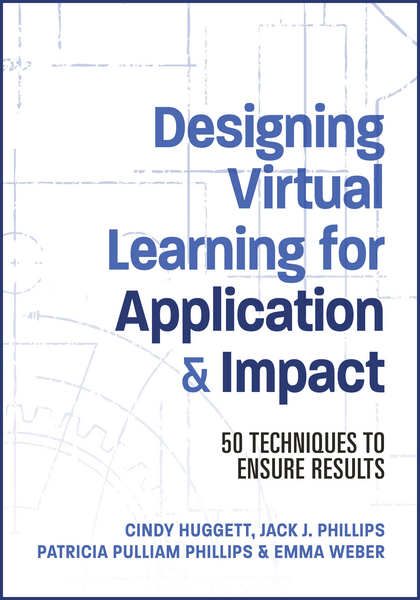ATD Blog
Ensure Virtual Learning Delivers Value Beyond the Classroom
Mon May 01 2023


Virtual learning is here to stay. And it must add value to an organization, otherwise it’s a waste of time and resources. In Designing Virtual Learning for Application and Impact: 50 Techniques to Ensure Results, virtual learning expert Cindy Huggett teams with evaluation experts Jack and Patti Phillips and learning transfer authority Emma Weber to create a guidebook for TD practitioners to ensure that their online programs achieve measurable results beyond the virtual classroom.
In this interview, Jack J. Phillips, Patricia Pulliam Phillips, Cindy Huggett, and Emma Weber outline what readers can expect to find in Designing Virtual Learning for Application & Impact.
What prompted you to assemble this author team and write this book at this time?
Patti and Jack: We have evaluated many virtual programs in the last few years. As evaluators, we see that they often fail to deliver results for application and impact. Our analysis always shows where it breaks down and what we need to do to make it different. This approach yields prescriptions for everyone involved in the programs, and this is the focus of this book.
For this book, we wanted to include the best virtual learning design person. In our opinion, that’s Cindy Huggett, who has years of experience in virtual learning and is the author of some of the best references for this area. Next, we wanted to ensure we had someone on the author team who understands the transfer of learning to the workplace. It was clear to us that Emma Weber, who has an extensive practice in this area and has also written a book on the topic, needed to be involved. Her model of turning learning into action is great prescriptive advice to ensure that virtual learning delivers the intended results. Together we tackled this issue from each of our perspectives, with Cindy taking the lead.
What are the benefits of evaluating virtual learning programs?
Patti and Jack: It’s important to evaluate major virtual learning programs at the impact and sometimes ROI level. Most learning teams evaluate at levels 1 and 2, reaction and learning, and rarely at levels 3, 4, and 5. However, the focus of this book pushes evaluation to levels 3 and 4, application and impact. When you do that, you show that you make a difference. You certainly please those who fund your program because they want to see the impact, and maybe even the ROI. It helps the learners’ managers who want to see results from learning in terms that they understand. Impact is critical as key performance indicators (KPIs) in the performance management systems. Evaluating at this level also helps identify where things can be improved. Process improvement is probably one of the best reasons for impact evaluation as it improves program results every time it’s offered.
Also, it is good for the entire team. All the stakeholders involved work together to ensure the program delivers value beyond the virtual classroom. It’s good to know that you are making a difference, and to make a difference, you must have application and impact.
Finally, evaluation helps retain funding. One of the biggest challenges is getting top leaders in an organization to recognize the value of what you do so they will continue to support you with budgets and other resources. Evaluating at the impact level, and occasionally at the ROI level, can show them that learning is an investment—an investment that yields a positive return. This can lead to greater support and resources.
What are some of the unique challenges to delivering impact with virtual learning programs?
Emma: Even more than other types of learning, special attention needs to be given to engagement in virtual learning. An unengaged learner isn’t learning and won’t create impact from your program. Your organization’s perception of virtual learning may be that it is less important than a face-to-face program, so it’s key to align all stakeholders, including learners and managers to the “why” behind the program, focusing on the business needs and objectives.
Bridging the gap between the learning phase of a virtual program and the application phase is key to delivering impact and the outcomes you designed the program for. Consider what ways you can leverage technology and different stakeholders to drive outcomes.
Who is the target audience for this book?
Patti and Jack: While there are many audiences, here are the most important ones. First, and most important, are those who design virtual learning programs. These individuals must step up to the challenge of designing for application and impact and not just stop with designing for learning. Second, those who implement and facilitate virtual learning programs need this book so they can ensure that these programs make a difference in the organization. Third, those who support learning from various perspectives will see value in this book because they will see their role in making the programs successful and know what others must do to make it successful. Finally, those who manage the learning and development function will see that designing at this level is necessary and measuring success all the way to ROI is possible and not that difficult.
How do I know which of the 50 techniques presented in the book will work best for my virtual learning program?
Patti and Jack: We have devoted an entire chapter in the book to selecting the right techniques, and we’ve included the selection by the author team for the best techniques along several dimensions in the book’s appendix. This document will be helpful in terms of what we think is best. You should gain some insight when you read the chapter and our collective responses.
What is best for you depends on your situation. There are often budget and time considerations. Can you afford the technique, or will you have the time to do it? What would work best? What would fit your culture? What would make the most sense with your program? So, much of it involves thinking through your situation and what you can do.
How do I get the designers, developers, facilitators, participants, the participants’ managers, and others on board with the processes outlined in the book?
Emma: The book details the ROI Alignment Model as a framework for engaging multiple stakeholders at different stages of the program. This is a robust way to ensure all stakeholders understand what is required and what will be delivered at each stage of the program. Focusing on the business “why” is a great place to start, then consider the different needs, availability, and motivations of your stakeholder groups. Taking time to understand what is important to them and how you can apply this to virtual learning will pay dividends.
What’s next for virtual learning?
Cindy: In recent years, virtual learning has vaulted from an option to a necessity for most organizations, and it’s not showing signs of slowing down anytime soon. Collaboration tools and online platforms continue to evolve and become more immersive. Technologies like artificial intelligence (AI), augmented reality (AR), and even virtual reality (VR) are available in virtual classrooms. These features have the potential to add depth and richness to the virtual experience, which will lead to better engagement, better learning, and ultimately better application and impact.
About the Authors
Cindy Huggett is a leading virtual training expert with over 30 years of experience with technology-enabled learning solutions. Cindy is a longtime trusted partner to Fortune 500 companies, government agencies, and businesses around the world. She upskills facilitators to create engaging online learning and helps organizations achieve success with their virtual and hybrid learning programs. She has written five acclaimed books on virtual training, including The Facilitator’s Guide to Immersive, Blended, and Hybrid Learning, and she is the co-author of Designing Virtual Learning for Application and Impact: 50 Techniques to Ensure Results. Cindy is a past member of the ATD global Board of Directors and was one of the first to earn the Certified Professional in Learning and Performance credential. Based in Raleigh, NC, she serves clients globally.
Jack J. Phillips, Ph.D., is aco-author of Designing Virtual Learning for Application and Impact and an award-winning thought leader in the field of talent development. As a teacher, consultant, and coach, he helps individuals show the value of their work in all types of organizations. Dr. Phillips has taught his proprietary methodology to over 50,000 professionals and managers in over 70 countries. He is a global keynote speaker and has written over 100 hundred books, focused on the importance of showing the value of the work. He has been recognized for his thought leadership by the Association for Talent Development, Thinkers50 Top Coaches, the International Society for Performance Improvement, the Society for Human Resource Management, and Meeting Professionals International. Dr. Phillips has served as an engineer, trainer, learning manager, HR executive, general manager, president, and college professor. He serves as chair of ROI Institute, a globally recognized consulting firm.
Patti P. Phillips, Ph.D., is a consultant, researcher, and co-author of Designing Virtual Learning for Application and Impact: 50 Techniques to Ensure Results. Her workshops and conference presentations inspire audiences to align their work with outcomes that matter. When she is not consulting with clients, researching, or writing books, Patti supports the work of other organizations through board service. She serves on the UN Institute for Training and Research board of Trustees, International Federation of Training and Development Organizations board, The Conference Board Human Capital Advisory Council, and the Institute for Corporate Productivity People Analytics Board. Patti has been recognized for her thought leadership by organizations such as the Association for Talent Development, Center for Talent Reporting, and the Thinkers50 Marshall Goldsmith Achievement for Coaching. She has written or contributed to over 50 books describing how individuals can demonstrate the value of their work.
Emma Weber is a learning transfer authority and CEO/Founder of Lever – Transfer of Learning. She has made it her mission in life to make a difference in learning transfer worldwide. Frustrated by the amount of learning which is wasted when it fails to make it across the knowing–doing gap Emma created the Turning Learning into Action™ methodology to solve that problem. This methodology is deployed throughout 20 countries and in 12 languages by a talented team and Coach M, a conversational intelligence chatbot. Coach M is challenging the industry's thinking of what’s possible in learning transfer. Emma shares her passion and expertise through her writing—her first book Turning Learning into Action: A Proven Methodology for Effective Transfer of Learning and now her 1st co-written book Designing Virtual Learning for Application and Impact.
About ATD and ATD Press
The Association for Talent Development (ATD) is the world’s largest association dedicated to those who develop talent in organizations. ATD’s members come from more than 120 countries and work in public and private organizations in every industry sector. ATD Press publications are written by industry thought leaders and offer anyone who works with adult learners the best practices, academic theory, and guidance necessary to move the profession forward. For more information, visit td.org/books.
Designing Virtual Learning for Application and Impact
ISBN: 9781953946775 | 248 Pages | Paperback
td.org/book/designing-virtual-learning-for-application-and-impact
To order books from ATD Press, call 800.628.2783.
To schedule interviews with any of the authors, please contact Kay Hechler, ATD Press senior marketing manager, at [email protected] or 703.683.8178.
You've Reached ATD Member-only Content
Become an ATD member to continue
Already a member?Sign In
